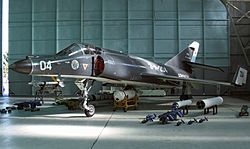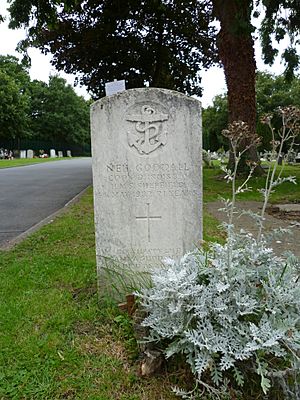HMS Sheffield (D80) facts for kids

HMS Sheffield
|
|
Quick facts for kids History |
|
|---|---|
| Name | HMS Sheffield |
| Ordered | 14 November 1968 |
| Builder | Vickers Shipbuilding and Engineering Ltd |
| Laid down | 15 January 1970 |
| Launched | 10 June 1971 |
| Sponsored by | Queen Elizabeth II |
| Commissioned | 16 February 1975 |
| Identification | Pennant number: D80 |
| Motto |
|
| Nickname(s) | Shiny Sheff |
| Fate | Foundered, 10 May 1982 |
| General characteristics | |
| Class and type | Type 42 destroyer |
| Displacement | 4,820 tonnes |
| Length | 125 m (410 ft 1 in) |
| Beam | 14.3 m (46 ft 11 in) |
| Draught | 5.8 m (19 ft 0 in) |
| Propulsion | 4 Rolls-Royce (2 Olympus TM3B and 2 Tyne) producing 36 MW COGOG (combined gas or gas) arrangement |
| Speed | 30 knots (56 km/h; 35 mph) |
| Complement | 21 officers and 249 ratings |
| Armament |
|
| Aircraft carried | Lynx HAS1 |
HMS Sheffield was a Type 42 guided missile destroyer of the Royal Navy. She was the second ship to be named after the city of Sheffield in Yorkshire. Commissioned on 16 February 1975, Sheffield was part of the Task Force 317 sent to the Falkland Islands during the Falklands War. She was hit and badly damaged by an Exocet missile from an Argentinian Super Étendard aircraft on 4 May 1982. She then sank while being towed on 10 May 1982.
Contents
Building HMS Sheffield
The order for Sheffield was placed in 1968. Her construction began on 15 January 1970 at Barrow-in-Furness by Vickers Shipbuilding and Engineering. During building, an explosion happened, killing two workers and damaging part of the ship's hull. This damaged section was replaced with a part from a similar ship, Hércules, which was being built for the Argentine Navy.
Queen Elizabeth II launched Sheffield on 10 June 1971. The ship was estimated to cost about £23.2 million to build.
Early Years and Testing
As the first ship of her class for the Royal Navy, Sheffield spent her first years testing new systems. This included the Sea Dart missile system. Another ship, HMS Bristol, was supposed to test the Sea Dart. However, it had serious fires and problems, so Sheffield took over much of this testing.
It wasn't until 1980 that Sheffield was fully ready for duty. After a refit in the early 1980s, some issues were found with the ship's Type 909 radar. This radar was important for controlling and aiming the Sea Dart missiles. The ship also did not have an electronic countermeasures (ECM) jammer, which helps protect against missiles.
Service Before the Falklands War
In June 1981, Sheffield took part in Exercise Roebuck. During this exercise, she fired five Sea Dart missiles. After another exercise called Ocean Safari, she sailed in November 1981 to patrol the Indian Ocean and Persian Gulf.
On 26 January 1982, Captain James Salt took command of the ship while it was undergoing maintenance in Mombasa. In March 1982, the ship traveled through the Suez Canal to join Exercise Spring Train in the Atlantic Ocean.
Heading to the Falklands
When Argentina invaded the Falkland Islands in March 1982, Sheffield was ordered on 2 April 1982 to join the task force. This force was being put together to take back the islands. The crew loaded supplies and ammunition. They also removed carpets and other items that could easily catch fire. To avoid being mistaken for the Argentinian ships Hércules and Santísima Trinidad, a black mark was painted on her funnel and down the side of the ship.
Sheffield left for the South Atlantic on 10 April. She arrived at Ascension Island on 14 April with other ships like HMS Arrow and HMS Coventry. They joined other vessels of Task Force 317. They began operations in the Total Exclusion Zone around the Falklands on 1 May 1982.
British policy stated that any Royal Navy ship that thought it was under missile attack should turn towards the threat. It should also speed up and fire chaff to protect itself. The special word to start this action was 'handbrake'. This word would be broadcast when the radar signal of a Super Étendard aircraft was picked up.
The Sinking of HMS Sheffield
The Attack by Argentina
An Argentinian patrol aircraft, a Lockheed P-2 Neptune, first spotted Sheffield at 7:50 AM on 4 May 1982. The Neptune kept watching the British ships. Two Argentine Navy Super Étendard planes, each carrying an AM39 Exocet missile, took off from Río Grande naval air base at 9:45 AM. They met a tanker plane to refuel.
Argentinian pilots had practiced attacking their own ships, including Type 42 destroyers like Sheffield. This meant they knew how to program the Exocet missile for the best attack. They flew very low to avoid being seen by radar.
At 10:35 AM, the Neptune plane climbed higher and found three contacts. A few minutes later, it told the Super Étendards where the ships were. The Super Étendards climbed twice to check their radar. Finally, they saw the targets on their screens.
Both pilots put the ship's location into their missile systems. They then returned to a low altitude. At 11:04 AM, each pilot launched an AM39 Exocet missile. They were about 20 to 30 miles (32 to 48 km) away from their targets. The Super Étendards then returned to base.
On Board Sheffield
Around 10:00 AM on 4 May, Sheffield was on defence watches. She was the southernmost of three Type 42 destroyers. These ships were acting as an anti-aircraft picket about 18 to 30 miles (29 to 48 km) west of the main task force. The weather was good and the sea was calm.
Before the attack, Sheffield's radar operators had trouble telling the difference between different types of enemy aircraft. The ship might also not have had good IFF (which identifies friendly aircraft) or radar jamming systems. Even though intelligence reports warned about Exocet attacks, Sheffield had thought the threat was not very high for the past two days.
The ship's radar could not detect low-flying aircraft. So, the two incoming enemy planes were not seen flying at 30 meters (98 feet). However, the UAA1 radar warning receiver detected the planes at 40 nautical miles (74 km). HMS Glasgow, another ship nearby, also saw the planes on its radar when they briefly climbed higher. Glasgow immediately went to action stations and sent the warning word 'Handbrake' to all ships.
On Sheffield, the crew was told to prepare their guns and missiles. The aircraft were seen on one of the ship's radars. However, the ship's satellite communications system then blocked another sensor. Seven seconds later, the first Exocet missile was fired. Glasgow fired its chaff to protect itself.
On Sheffield, the crew only realized they were under attack when they saw smoke from the missile. The officers on the bridge did not call the captain or order the ship to action stations. They also did not prepare the guns or missiles, or order chaff to be fired.
Two Exocet missiles had been launched. The second missile missed Sheffield and splashed into the sea about 0.5 nautical miles (0.93 km) off her left side. The Exocet that hit Sheffield struck her on the right side, at deck level 2. It went through the junior ratings’ scullery and broke through a bulkhead. This created a hole in the hull about 1.2 meters (3.9 feet) by 3 meters (9.8 feet). The missile's impact damaged the ship's electrical systems and the fire main, which was used for fighting fires. This damage made it very hard to fight the fire, which eventually destroyed the ship.
Lives Lost
Out of 281 crew members, 20 died in the attack. Most of them were in the galley (kitchen) area and computer room. Another 26 crew members were injured, mainly from burns, smoke, or shock. Only one body was recovered. The survivors were taken to Ascension Island. The wreck of Sheffield is now a war grave and is protected by law.
What We Learned
After the ship was lost, a special investigation was held by the Ministry of Defence. The report from this investigation was completed on 28 June 1982. The report pointed out several important reasons why Sheffield was lost:
- The ship did not react quickly enough to HMS Glasgow's warning about the approaching enemy planes. They should have gone to action stations, activated their missiles, and launched chaff decoys immediately.
- The ship did not have a system to jam enemy electronic signals.
- The ship lacked a point defence system, which is a close-range weapon to protect against missiles.
- The crew needed more training, especially for detecting low-flying targets.
- The ship's radar was slow to respond.
- The fire spread quickly because of materials that easily caught fire. There were also not enough breathing devices for firefighters, and some escape routes were too small.
The captain's actions after the missile hit and his decision to abandon the ship were not criticized. Later, in 2015, a new study by the Ministry of Defence confirmed that the Exocet missile's warhead did explode inside Sheffield. This was based on new analysis tools and evidence from other weapon tests.
In 2017, a full copy of the report was released. It showed that the ship was not fully ready for the attack. For example, the officer in charge of air defense was not in the operations room when the attack happened.
The Fire and Ship Materials
Some people mistakenly thought that Sheffield sank because its upper structure was made of aluminium. Aluminium has a lower melting point than steel. However, Sheffield's upper structure was actually made entirely of steel. This confusion might have come from other ships that had aluminium parts and suffered fires in the 1970s.
The fires on Sheffield and other ships led to an important change for the Royal Navy. Sailors used to wear clothes made of nylon and other synthetic fabrics. These fabrics would melt onto the skin when burned, causing more severe injuries. After the Falklands War, the Royal Navy changed to non-synthetic clothing for its sailors.
Images for kids
See also
 In Spanish: HMS Sheffield (D80) para niños
In Spanish: HMS Sheffield (D80) para niños




